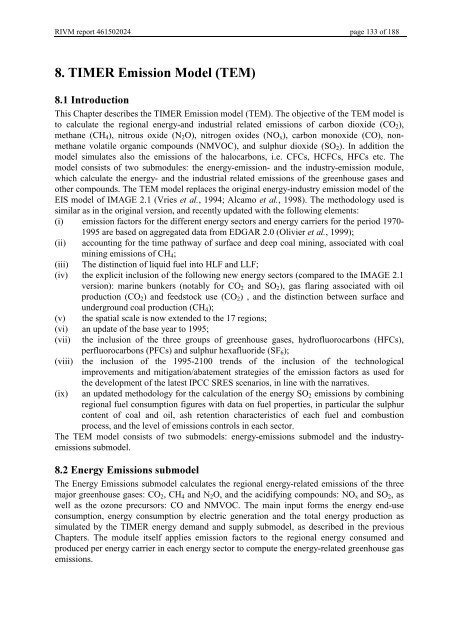Targets IMage Energy Regional (TIMER) Model, Technical ...
Targets IMage Energy Regional (TIMER) Model, Technical ...
Targets IMage Energy Regional (TIMER) Model, Technical ...
Create successful ePaper yourself
Turn your PDF publications into a flip-book with our unique Google optimized e-Paper software.
RIVM report 461502024 page 133 of 188<br />
7,0(5(PLVVLRQ0RGHO7(0<br />
,QWURGXFWLRQ<br />
This Chapter describes the <strong>TIMER</strong> Emission model (TEM). The objective of the TEM model is<br />
to calculate the regional energy-and industrial related emissions of carbon dioxide (CO 2 ),<br />
methane (CH 4 ), nitrous oxide (N 2 O), nitrogen oxides (NO x ), carbon monoxide (CO), nonmethane<br />
volatile organic compounds (NMVOC), and sulphur dioxide (SO 2 ). In addition the<br />
model simulates also the emissions of the halocarbons, i.e. CFCs, HCFCs, HFCs etc. The<br />
model consists of two submodules: the energy-emission- and the industry-emission module,<br />
which calculate the energy- and the industrial related emissions of the greenhouse gases and<br />
other compounds. The TEM model replaces the original energy-industry emission model of the<br />
EIS model of IMAGE 2.1 (Vries HWDO, 1994; Alcamo HWDO, 1998). The methodology used is<br />
similar as in the original version, and recently updated with the following elements:<br />
(i) emission factors for the different energy sectors and energy carriers for the period 1970-<br />
1995 are based on aggregated data from EDGAR 2.0 (Olivier HWDO, 1999);<br />
(ii) accounting for the time pathway of surface and deep coal mining, associated with coal<br />
mining emissions of CH 4 ;<br />
(iii) The distinction of liquid fuel into HLF and LLF;<br />
(iv) the explicit inclusion of the following new energy sectors (compared to the IMAGE 2.1<br />
version): marine bunkers (notably for CO 2 and SO 2 ), gas flaring associated with oil<br />
production (CO 2 ) and feedstock use (CO 2 ) , and the distinction between surface and<br />
underground coal production (CH 4 );<br />
(v) the spatial scale is now extended to the 17 regions;<br />
(vi) an update of the base year to 1995;<br />
(vii) the inclusion of the three groups of greenhouse gases, hydrofluorocarbons (HFCs),<br />
perfluorocarbons (PFCs) and sulphur hexafluoride (SF 6 );<br />
(viii) the inclusion of the 1995-2100 trends of the inclusion of the technological<br />
improvements and mitigation/abatement strategies of the emission factors as used for<br />
the development of the latest IPCC SRES scenarios, in line with the narratives.<br />
(ix)<br />
an updated methodology for the calculation of the energy SO 2 emissions by combining<br />
regional fuel consumption figures with data on fuel properties, in particular the sulphur<br />
content of coal and oil, ash retention characteristics of each fuel and combustion<br />
process, and the level of emissions controls in each sector.<br />
The TEM model consists of two submodels: energy-emissions submodel and the industryemissions<br />
submodel.<br />
(QHUJ\(PLVVLRQVVXEPRGHO<br />
The <strong>Energy</strong>Emissions submodel calculates the regional energy-related emissions of the three<br />
major greenhouse gases: CO 2 , CH 4 and N 2 O, and the acidifying compounds: NO x and SO 2 , as<br />
well as the ozone precursors: CO and NMVOC. The main input forms the energy end-use<br />
consumption, energy consumption by electric generation and the total energy production as<br />
simulated by the <strong>TIMER</strong> energy demand and supply submodel, as described in the previous<br />
Chapters. The module itself applies emission factors to the regional energy consumed and<br />
produced per energy carrier in each energy sector to compute the energy-related greenhouse gas<br />
emissions.
















